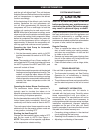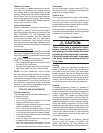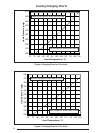
11
FUNCTIONAL CHECKOUTS
CAUTION:
These units have a crankcase heater
factory installed. Wait 24 hours prior to
performing a function checkout to allow
for heating of the compressor crankcase.
Failure to comply may result in damage
and could cause premature failure of
the system.
Cooling
Gradually lower the thermostat temperature
setpoint below the actual room temperature
and observe that the outdoor unit and indoor
blower energize. Feel the air being circulated
by the indoor blower and verify that it is cooler
than ambient temperature. Listen for any unusual
noises. If unusual sounds occur, determine the
source of the noise and correct as necessary.
Heating
If heating equipment (furnace, air handler) is
provided with the system, lower the thermostat
setpoint temperature to the lowest temperature
setting and change the thermostat’s function
mode to HEAT. The outdoor unit should stop
running and the indoor blower will shut off after the
preprogrammed delay. Increase the thermostat’s
setpoint temperature to the maximum setting.
Verify the heating equipment and the indoor
blower energize after a short period of time. Feel
the air being circulated by the indoor blower and
verify that it is warmer than ambient temperature.
Listen for any unusual noises. If unusual sounds
occur, determine the source of the noise and
correct as necessary.
NOTE: Other sources for heating (electric
furnace, fossil fuel furnace, air handler with
electric heat options, etc.) that interface with
the heat pump should be functionally checked to
Outdoor Fan Motor
If unit utilizes a 2-speed condenser fan motor,
this motor will operate on low speed when in
low cooling, and on high speed when in high
cooling. A relay within the control area switches
the fan motor from low to high speed using the
call for high cooling as the trigger. Other models
that utilize BLDC fi xed torque variable speed fan
motors will not require a relay.
Optional Equipment
Optional equipment requiring connection to
the power or control circuits must be wired in
strict accordance with current provisions of the
NEC (ANSI/NFPA 70), with applicable local
codes having jurisdiction, and the installation
instructions provided with the equipment.
Optional Equipment (low ambient control,
hard start kits, etc.) should be installed in strict
accordance with the manufacturer’s installation
instructions
Transformer Upgrade Kit
If this 2-stage heat pump is installed in conjunction
with a gas furnace and fossil fuel kit, the furnace
transformer MUST be upgraded to one with a 60
VA rating or using the transformer upgrade kit
(904077). To upgrade the transformer:
• Remove the existing transformer and install
the new 60 VA transformer.
• Remove the 3 amp fuse on the furnace control
board and install the 5 amp fuse provided.
NOTE: The new transformer may be larger
than the existing transformer that is mounted in
the furnace. If this happens, mount the 60 VA
transformer using one of the mounting holes in
the furnace panel. On the other side either drill
a 0.149 hole in the panel and use the existing
fastener, or use a self-drilling fastener to secure
the other side of the transformer.
STARTUP AND ADJUSTMENTS
Pre-Start Checklist
The following check list should be observed prior
to starting the unit.
Is the unit level?
Is the wiring correct according to the wiring
diagram and electrical codes?
Inspect wiring for evidence of open, shorted,
and/or improperly wired circuits.
Are all the wiring connections tight? Check
the condenser fan to make sure it turns freely.
Is the overcurrent protection properly sized?
Is the thermostat wired correctly? Is it installed
in a proper location?
Verify air fi lters are clean and in place prior
to operating the equipment.
Verify the outdoor coil and top of the unit are
free from obstructions and debris, and all
equipment access/control panels are in place.
Thermostat
Set the thermostat’s system mode to OFF, the
fan mode to AUTO, and adjust the temperature
setpoint to its highest setting.
Outdoor Unit
Prior to applying electrical power to the outdoor
unit, verify that the unit has been properly and
securely grounded, and that power supply
connections have been made at both the facility
power interface and outdoor unit.
Verify the outdoor coil and top of the unit are free
from obstructions and debris, and all equipment
access/control panels are in place.


















